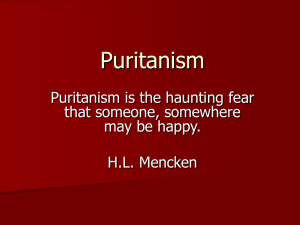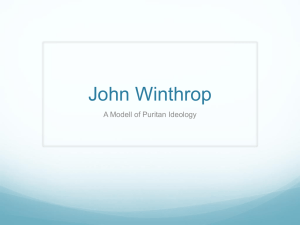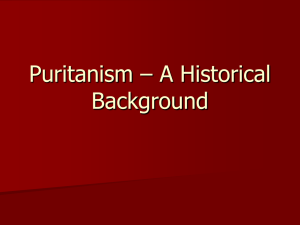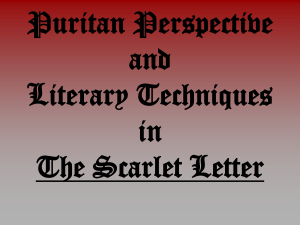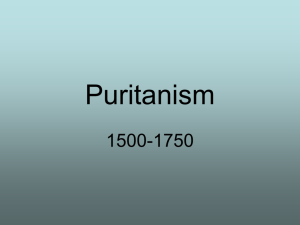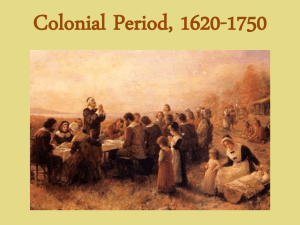PURITANISM IN NEW ENGLAND SEMINAR ONE
advertisement
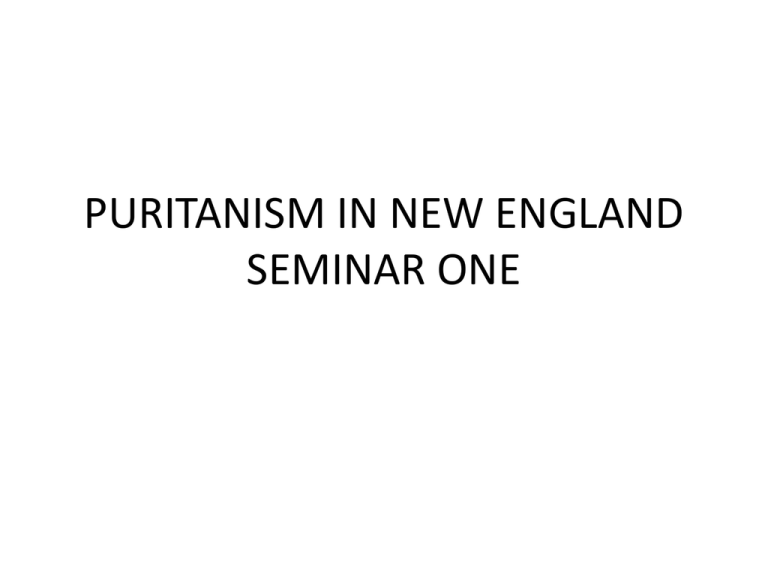
PURITANISM IN NEW ENGLAND SEMINAR ONE ABOUT PURITANISM IN GENERAL • Total Depravity - through Adam and Eve's fall, every person is born sinful - concept of Original Sin. • Predestination-only a few are selected for salvation • Limited Atonement - Jesus died for the chosen only, not for everyone. • Irresistible Grace - God's grace is freely given, it cannot be earned or denied. Grace is defined as the saving and transfiguring power of God-covenant of grace • Perseverance of the "saints" –only visible saints can interpret divine intent • Typology: God’s will can be discerned in human action and natural phenomena MORE PURITAN BELIEFS…. • A cyclical or repetitive view of history. History contains types Moses prefiguring Jesus, Jonah’s patience is reflected in Jesus’s piety on the cross, Moses as forerunner to Pilgrims crossing the Atlantic • Beware of backsliding, weakening of faith. Importance of constant soul searching, selfexamination, constant prayer in order to avoid sin and temptation FUNCTIONS OF PURITAN WRITERS • To interpret God’s will to the average person • To demystify, yet glorify God • To show the Bible and God’s relevance to everyday life and the universe THE RISE OF PURITANISM • The forming agent of literary and cultural consciousness • Desire to form the new Zion • Reformation in England: • Forerunners: Wycliff, and the Lollards • Demand for the vernacular translation of the Bible THE PURITAN SERMON • William Perkins: The Art of Prophecying (1607) • Text-reading the Biblical passage • Doctrine- explaining, interpreting the text, prepare the audience for the argument • Reasons-connect the text with other parts of the Bible, minister justifies the doctrine, paragraphs, sub-paragraphs • Apllications-apply the teaching to the life of the believer, to the actual moment REFORMATION IN EUROPE • • • • Reformation in Europe, (Luther, Calvin) Henrician reformation Act of Supremacy, 1534 Under Edward VI, Calvinism becomes more popular • 1552: Book of Common Prayers, a more Calvinist edition • 1559: Elizabeth I, The Second Act of Supremacy REFORMATION IN EUROPE • Division of Protestants in the European continent: • Luther, Calvin, • Scotland: John Knox: Presbyterianism: Church is governed by elected leaders, presbyters (secular and lay) • Church of England: Anglican church, preserves the hierarchy of the Roman Catholic church, led by bishops, archbishops • Elizabeth: able to find compromises, yet promotes a medium rank Protestantism • 1603: James I, persecution of Puritans, Archbishop Laud, follower of Arminianism THE CONCEPT OF PURITANISM • A dogma system • A philosophy of church organization • A work ethic THE CONCEPT OF PURITANISM • 1549: Bishop John Hooper: became familiar with the teaching of Zwingli and Calvin in Geneva, was already promoting Puritanism, rejected any attempt reminiscent of Popism • When did the term come into use? During Mary I, when the radical reformists, non-conformists had to escape to Europe • Anglicans later used the term Puritan to all their opponents: including Presbyterians, Independents, and Baptists • 1620s: the meaning of the term Puritan changes: previously everyone opposing church hierarchy was called as such, now those turning against Arminianism were named this way ARMINIANISM vs. PURITANISM • Jacob Arminius,(1560-1609) denied the basic points of Calvinism: • Due to the Fall man is branded by the notion of Original Sin • Man cannot gain redemption • Good deeds cannot help you to ascend to Heaven, only through faith • Christ only died for the chosen ones • God provides grace only for those predestined SO THEN WHAT DID HE BELIEVE IN? • The Five Articles of Remonstance: -universal grace for those who persevere in faith -Christ died for everyone -Unlimited, universal atonement -Resistible grace: people can resist the Holy Ghost -Libertarian free will: our choices are free from the determination or constraints of human nature and free from any predetermination by Godindividual decides on accepting election by God THE SUCCESS OF THE DOCTRINE • What is the political significance of Puritanism: • chosen few not only led congregations but governed as well • Further development of Calvinism: William Perkins, (1558-1602) recognizes that only the privileged groups can become predestined, thus promotes that through knowledge of the Bible less privileged groups can gain that status. Puritan dogma has to be made understandable, intelligible for less educated groups, promotion of the plain style THE SUCCESS OF THE DOCTRINE • • • • • emphasis on redemption addressed the individual not social classes attractive for all groups elite, educated hoped to belong to those chosen Landlords, businessmen: work ethic tempers discontent, eliminates church holidays (more than 100 a year) , greater productivity • peasants, miners, other less privileged: find solace in the democratic aspects JOHN COTTON (1584-1652) • Dean of Emmanuel College, Cambridge • Dominant theologian, wrote position papers defending Puritanism • Dreamed of a Utopia of Saints • A scholar and a gentleman • A most universal scholar, a living system of liberal arts, and a walking library—Cotton Mather • God would not suffer Mr. Cotton to err JOHN COTTON (1584-1652) • crabbed style, ascetic reasoning, Renaissance spirit • a soul melting preacher, believed in the power of the spoken word • by nature a tolerant man • After the Hutchinson trial he gave in to the rising tide of intolerance • Became an apologist for the excesses of Puritanism • negates democracy and hereditary aristocracy JOHN COTTON (1584-1652) • Farewell sermon: before Massachussetts Bay Company leaves England in 1630 • providing Biblical support for emigration • to deflect charges of betrayal of colonists’ native land • justifying the taking of Indian land • warning of straying far from religion • protection against degeneration Gods Promise to His Plantations • • • • I will appoint a place for my people Israell Model for colonization, colonial life He would accept a house from Solomon Establish the throne of his house for ever Gods Promise to His Plantations • Three-fold blessings: • They shall dwell there like Free-holders in a place of their owne • Firme and durable possession,they shall move no more • They shall have peacable and quiet resting there Gods Promise to His Plantations • Which part of the document reflect the notion of chosenness? • The placing of a people in this or that countrey is from the appointment of the Lord • How did God appoint this place? • He had espied the land for them • Takes them there • Makes room for them to dwell Gods Promise to His Plantations • • • • Causes of the Great Protestant Migration: gain of knowledge for merchandize and gaine-sake to plant a colony, to settle a City or Commonwealth Gods Promise to His Plantations • to be able to employ talents and gifts better elsewhere • for the liberty of Ordinances, to escape from persecution • Push factors—evills to be avoyded that may warrant removeall: • a prophecy foreseeing persecution • economic causes: overburdened with debts and miseries • to please God STUDY QUESTIONS • Define some of the basic concepts of Puritan ideology and illustrate their significance in specific works. Choose from among the following: (a) "new world" consciousness, (b) covenant theology, (c) typology, (d) innate depravity, and (e) irresistible grace. • Identify the components of the Puritan sermon in the text THE PURITAN MINDSET • Original sin condemned mankind to a life of labor, suffering, and death • Through Crucifixion those reborn or experiencing conversion are saved • Churches should be comprised of people with no sin, visible saints • no hierarchic church system • Church and state are aspects of the same structure designed to carry out God’s will on Earth • innate human depravity makes governments necessary: if people be governors who shall be governed • Peaceable kingdoms, stable societies THE PURITAN MINDSET • stronger family life, more cohesive village life than in England (Andover, Dedham, Plymouth) • importance of the covenant with God—covenant of grace • Covenant sealed by Baptism and the Lord’s Supper • Chosenness • Mission concept • Importance of work and industry • Moderation except in piety JOHN WINTHROP (1588-1649) • Raised on an estate (Groton, England) purchased from Henry VIII • Studied at Cambridge University • Married at age 17 • Practiced law • Congregationalist, wants to reform the church from within • 1620: Severe economic depression • Company of Mass. Bay in N. England receives a charter • Winthrop is chosen for governor • Aboard Arbella delivers his sermon • ”A Model of Christian Charity” A Modell of Christian Charity • John Winthrop’s (1588-1649) model for America • An example of the emotional history of the U.S. • A blue print for American exceptionalism A Model of Christian Charity • Foundations of the model: • agape—understanding, love, Christian brotherhood, fellowship • caritas:charity • Paul’s first letter to the Corinthians, three gifts available to believers: faith, hope, charity • Thomas Aquinas’ notion of charity • Moral or communal capitalism A Modell of Christian Charity • General view of society: some must be rich, some poore • The King will have many Stewards– a servant in realizing a divine plan • Soe that the riche and mighty should not eate upp the poore, nor the poore and dispised rise upp against their superiours • Knit together in the Bonds of brotherly affection • Justice and mercy: two basic rules for life • Mathew 5.44 Love your Enemies A Modell of Christian Charity • The duty of mercy: giving, lending, and forgiving • Love is the bond of perfection • It makes the worke perfect • Most perfect of all bodies: Christ and his church • Christians are one body in Christ united by love A Modell of Christian Charity • What kind of love? • Spiritual, nature free, active strong, courageous, permanent • Resembles the virtue of the Heavenly Father A Modell of Christian Charity (1630) • The foundation of the Christian commonwealth • Persons: professing themselves fellow members of Christ • The worke: Cohabitation and Consorteshipp under a due forme of government both civill and ecclesiasticall • The end: to serve the Lord and worke out our Salvation under the power and purity of his holy ordinances A Modell of Christian Charity • The means: Wee must beare one anothers burthens • We are entered into Covenant with him • We follow the counsell of Micah: doe justly, love mercy, walk humbly • Matthew 5:14 For wee must Consider that wee shall be as a Citty upon a Hill • A city that is set on the hill cannot be hid. Neither do men light a candle and put it under a bushel, but on a candlestick. • • • • A foundational document Compact made among Americans Covenant with the Supreme Being A community united in charity THE AMERICAN JEREMIAD • Sacwan Bercowitch: a sermon creating tension between ideal social life and reality • --provide a biblical or spiritual standard for individual activity or public life • --describe how people fail to meet this standard • --describe an ideal public life following a return to religious standards • Hope v. fear, ideal v. real • Reagan’s city upon a hill CAPTIVITY NARRATIVES • • • • • • Historical background The worsening of settler-Indian relations Aggressive expansion of whites Undermining Indian spirituality Aggressive expansion of Christianity Encroachment on Indian land CAPTIVITY NARRATIVES • Indian wars • 1622-1632: Powhatan war • 1637: Pequot war • 1675-76: King Philip’s (Metacomet) War CAPTIVITY NARRATIVES • Conflicts at the Frontier—contact zone • Captives are taken for making them work as slaves • For ransom • For making up a loss in the family • For being sold to other tribes THE INDIAN CAPTIVITY NARRATIVE • 1528-1903 • Basic theme: separation, transformation, return (staying with Indians) • Narratives of confinement: Barbary coast captivity, slave narrative, convent captivity narratives, captured by UFO narratives • Indian captivity narrative: forerunner of the American novel THE FUNCTIONS OF THE INDIAN CAPTIVITY NARRATIVE • Roy Harvey Pearce: • Religious confessional • Propaganda (Indian, or French as the archenemy) • Penny dreadful—dime novels • Self-fashioning (Ogushi) –establishment of identity MARY ROWLANDSON (1682) • Attack on Lancaster, Mass. 1675, February 10 • Captured with injured six year old daughter, Sarah • Self-fashioning, rebuilding identity • Motherhood-loses Sarah, yet figurative mother to Indian children • Sewing clothes • Biblical patterns, typology, Loth’s wife, Job COTTON MATHER: MAGNALIA CHRISTII AMERICANA (1702) • Nehemias Americanus. The Life of John Winthrop • Who does the author compares Winthrop to: --Lycurgus of Sparta, Numa Pompilius of Romeauthor of Roman laws --Family relationship to Archdeacon of Winchester What elements of his life predestined him for being a leader of the Massachussetts colony? served as Justice of the Peace at 18, he was impartial, Weighing not cash, but the case, learned more than the seven arts -- NEHEMIAS AMERICANUS • How would you describe his governing approach? • Governed by moderation, called by one of his enemies: John Temperwell • How did he justify his leniency? In the infancy of plantations, justice should be administered with more lenity than in a settled state—lento gradu— by slow degrees • How did he function as Nehemiah?—had to contend with his own Sanballats (opponents) Roger Williams, • Anne Hutchinson NEHEMIAS AMERICANUS • How did he create the image of the just leader? • Sending his family into the houses of the poor, in case of want, providing for them, curing poor of stealing— providing them with wood for the winter • A mixed man: • When serving as deputy governor in 1645 he was accused of violating civil liberties, but acquitted • His interpretation of the covenant: corrupt liberty undermines the covenant, grand enemy of truth and peace, moral, civil, federal liberty:proper end and object of authority NEHEMIAS AMERICANUS • • • • Promoted temperance Three wives Business problems He left behind as an eternal memorial, the walls of New England WHAT IS THE OVERALL IMAGE? • Communitiy minded • Displays Puritan values: sobriety, frugality, sharing his wealth • Believes in moderation • Wise statesman, reliable leader • Prophetic visionary A CHRISTIAN AND HIS CALLING • General Calling: serve the Lord Jesus Christ, save one’s own soul • Personal Calling: demonstrate usefulness in a given employment • A Christian is like a man in a boat rowing for Heaven, if he follows only one of the Callings he will not reach the shore THE PERSONAL CALLING • • • • • Every Christian should have an occupation, or business First Adam, Second Adam had a calling Sin of Sodom, abundance of idleness We are to live soberly, righteously How should the occupation be carried out: industriously, with discretion, honesty, contentment • Business of Personal Calling should not swallow General Calling • Obedience to God be a spring to your business • Spiritualize your business, have devotionary thoughts during your workday THE JOURNAL OF MADAM KNIGHT • Sarah Kemble Knight (1666-1727) • First daughter of Thomas Kemble and Elizabeth Trerice Kemble • Born in Boston, married Richard Knight • Prior to husband’s death in 1706 she takes over business tasks • Worked as a court scrivener, organized a writing school, ran a boarding house • The Journal describes her trip (Boston to New York) made between October 2, 1704-March 3, 1705 THE JOURNAL OF MADAM KNIGHT • Trip made fully on horseback • Second travel text written by a woman after the Rowlandson Narrative • Breaking into a male sanctuary, the travel book • Goal of the trip: settling the estate of deceased cousin, Caleb Trowbridge • The Journal was published together with the Narrative of Reverend Thomas Buckingham in 1825 THE JOURNAL OF MADAM KNIGHT • • • • Not a spiritual narrative Self-examination is missing The writing has no faith protection function Theodore Dwight’s Preface: “a fateful copy from a diary in the author’s own handwriting […] a lady of uncommon literary attainments as well as of great taste and strength of mind.” THE JOURNAL OF MADAM KNIGHT • • • • Partial inscription into the symbolic order Gaps in the power system (Foucault) The limits of the female author Objectification of the Other THE PROCESS OF SUBJECTIVATION • Subject: a fluid concept • Subjectivation: making someone a subject (speaking, acting Self, agent) or subordinate someone to the power or the establishment • Power is not homogeneous, it has gaps (Foucault) • During the process of encountering power the indvidual becomes subject (assujettissement) PERFORMANCE V. PERFORMATIVITY • Means of subject formation: subject is constructed by acquiring socially and culturally determined roles • Performance: a mimetic replaying of norms and the replaying of ruling ideologies when constructing the subject • Performative acts allow people to construct themselves, subjects are created performatively in the speaking and the doing • ”most salvage of all the salvages of that kind that I had ever Seen” • ”but are not proper to be Related by a Female pen” • ”The Raptures wch the Sight of that fair Planett produced in mee, caus’d mee, for the Moment, to forgett my present wearyness and past toils” • ”and the Tall and thick Trees at a distance, especially when the moon glar’d light through the branches, I fill’d my Imagination with the pleasent delusion of Sumpteous city fill’d with famous Buildings, and churches, wth their spiring steeples, Balconies, Galleries and I know not what:” • ”But desire sincearly to adore my Great Benefactor for thus graciously carrying forth and returning in safety his unworthy handmaid.”
